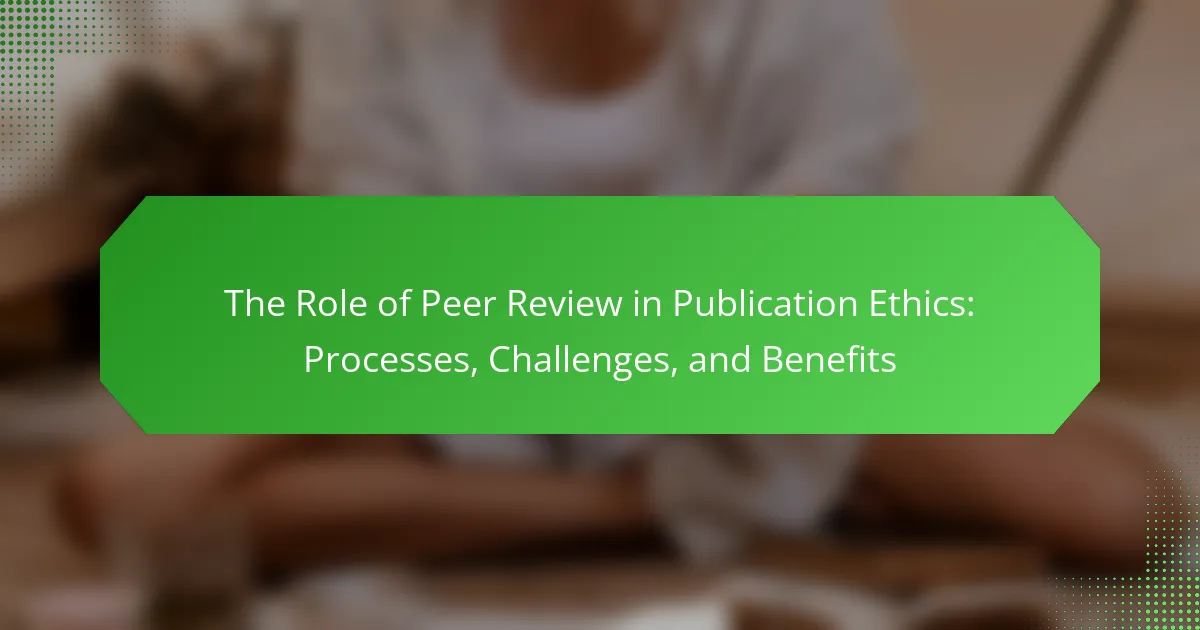Peer review is a fundamental mechanism in publication ethics, ensuring the integrity and quality of scholarly work. It involves a systematic process where experts evaluate the originality, validity, and significance of submitted manuscripts, thereby preventing the dissemination of flawed or unethical research. While peer review promotes accountability and trust within the academic community, it also faces challenges such as bias, inconsistency, and delays. This article examines the processes involved in peer review, highlights its benefits in enhancing research quality, and addresses the challenges that can undermine its effectiveness in scholarly publishing.
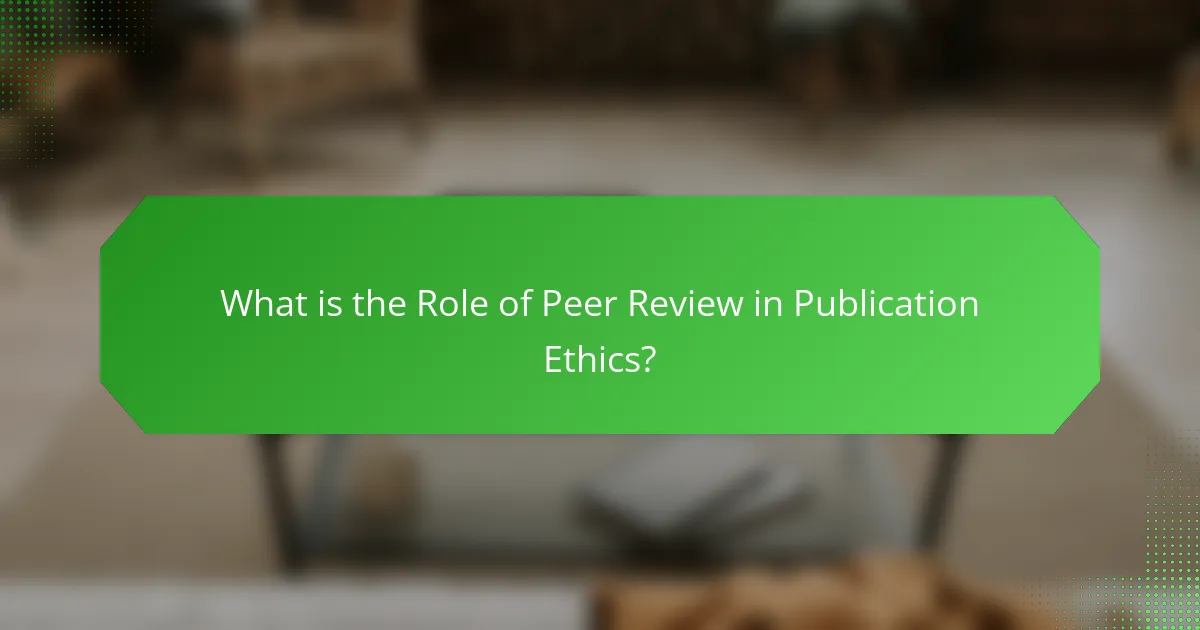
What is the Role of Peer Review in Publication Ethics?
Peer review serves as a critical mechanism in publication ethics. It ensures the integrity and quality of scholarly work. Reviewers evaluate the originality, validity, and significance of submitted manuscripts. This process helps prevent the dissemination of flawed or unethical research. Peer review also promotes accountability among authors and publishers. It fosters transparency and trust within the academic community. Studies indicate that rigorous peer review improves the overall quality of published research. Thus, peer review is essential for maintaining ethical standards in scholarly publishing.
How does peer review contribute to the integrity of academic publishing?
Peer review enhances the integrity of academic publishing by ensuring rigorous evaluation of research. This process involves experts assessing the quality and validity of submitted work. Reviewers check for methodological soundness and relevance to the field. They also identify potential biases and conflicts of interest. The feedback from reviewers helps authors improve their manuscripts. This leads to higher-quality publications. According to a study published in the journal “Nature,” peer-reviewed articles are more likely to be cited than non-peer-reviewed ones. This indicates greater trust in the findings. Overall, peer review acts as a safeguard against misinformation in academia.
What are the key principles of publication ethics in peer review?
The key principles of publication ethics in peer review include transparency, confidentiality, and impartiality. Transparency requires that reviewers disclose any conflicts of interest. Confidentiality mandates that reviewers do not share the content of the manuscript with others. Impartiality means that reviews should be based on the quality of the work, not on personal relationships or biases. Additionally, ethical peer review includes providing constructive feedback. Reviewers should aim to enhance the manuscript’s quality through their critiques. These principles help maintain the integrity of the publication process. Adhering to these standards fosters trust in academic publishing.
How does peer review ensure quality and validity in research?
Peer review ensures quality and validity in research by subjecting scholarly work to evaluation by experts in the field. This process identifies flaws, biases, and methodological issues before publication. Reviewers assess the research’s significance, originality, and adherence to ethical standards. They provide constructive feedback to improve the manuscript. Studies show that peer-reviewed articles are more likely to be reliable and impactful. For instance, a 2016 analysis found that peer-reviewed studies had a higher citation rate compared to non-peer-reviewed ones. This indicates that peer review enhances the credibility of published research.
Why is peer review considered essential in the publication process?
Peer review is considered essential in the publication process because it ensures the quality and credibility of academic research. This process involves experts evaluating a manuscript before publication. Their feedback helps identify errors, biases, and gaps in the research. Peer review also enhances the rigor of scientific inquiry. A study published in the journal Nature found that peer-reviewed articles are more likely to be cited than non-peer-reviewed ones. This indicates that peer review contributes to the overall integrity of the scientific literature. Furthermore, it fosters trust among researchers and the public in published findings.
What are the main benefits of peer review for authors?
Peer review provides authors with several key benefits. It enhances the quality of their work through constructive feedback. Reviewers often identify gaps or weaknesses in research that authors may overlook. This process leads to improved clarity and rigor in the manuscript.
Additionally, peer review can increase the credibility of the published work. It serves as a validation from experts in the field. This validation can boost the author’s reputation and professional standing. Furthermore, peer review often helps authors gain insights into current trends and standards in their field.
Research indicates that articles undergoing peer review tend to be more widely cited after publication. A study published in the journal “PLOS ONE” found that peer-reviewed articles had a higher citation impact than non-reviewed ones. Thus, peer review plays a crucial role in enhancing both the quality and visibility of scholarly work.
How does peer review protect the interests of the scientific community?
Peer review protects the interests of the scientific community by ensuring the quality and integrity of research before publication. It involves experts evaluating the validity and significance of submitted work. This process helps identify errors, biases, or unethical practices. By maintaining high standards, peer review enhances public trust in scientific findings. Research shows that peer-reviewed articles are more likely to be reliable and impactful. The peer review system also fosters constructive feedback, improving the overall quality of research. Ultimately, it safeguards the credibility of the scientific enterprise.
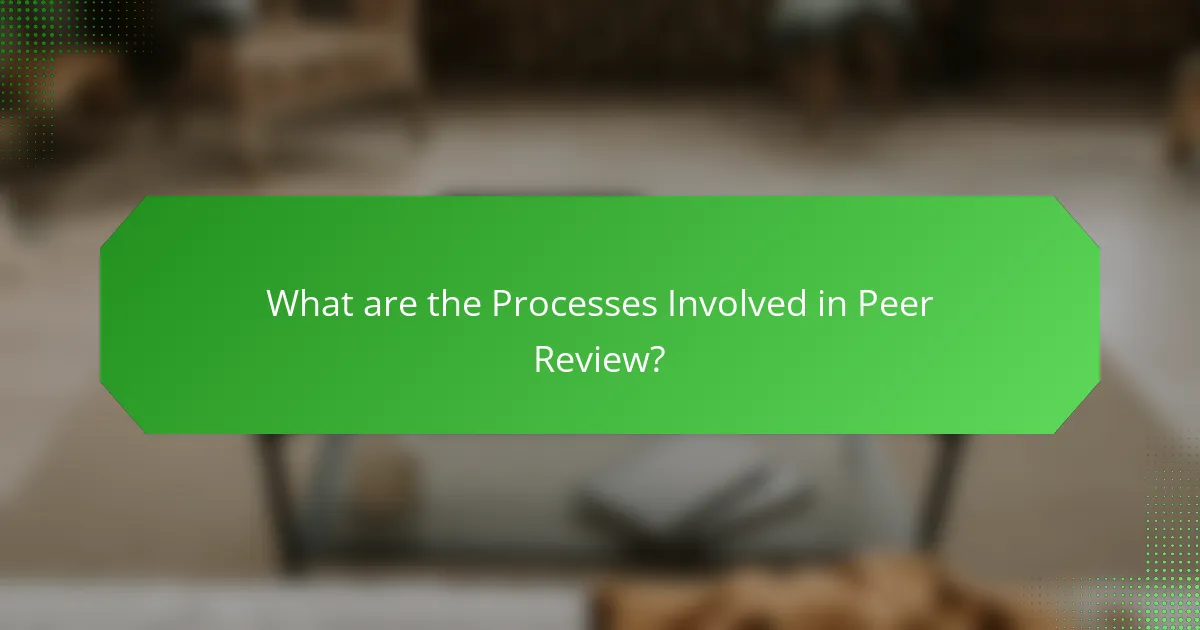
What are the Processes Involved in Peer Review?
The processes involved in peer review include several key steps. First, an author submits a manuscript to a journal. The journal editor then screens the manuscript for suitability. If suitable, the editor identifies and invites experts in the field to review the manuscript. Reviewers evaluate the manuscript’s quality, originality, and relevance. They provide feedback and recommendations to the editor. The editor makes a decision based on the reviewers’ comments. Possible decisions include acceptance, revision, or rejection of the manuscript. This process ensures the integrity and quality of published research.
How does the peer review process typically unfold?
The peer review process typically unfolds in several key stages. Initially, an author submits a manuscript to a journal. The journal editor evaluates the submission for relevance and quality. If deemed suitable, the editor sends the manuscript to expert reviewers in the field. Reviewers assess the manuscript’s methodology, validity, and contribution to the field. They provide feedback and recommendations to the editor. The editor then makes a decision based on the reviewers’ comments. This decision can be acceptance, revision, or rejection. Finally, the author receives the feedback and revises the manuscript if necessary. This structured approach ensures the quality and integrity of published research.
What are the different stages of the peer review process?
The peer review process consists of several distinct stages. Initially, a manuscript is submitted to a journal. The journal editor assesses the submission for relevance and quality. If deemed suitable, the editor sends the manuscript to expert reviewers. These reviewers evaluate the work for originality, validity, and significance. After review, they provide feedback and recommendations to the editor. The editor then makes a decision on the manuscript, which may include acceptance, revision, or rejection. Authors are notified of the decision and may revise their work if requested. Finally, the manuscript may be published if it meets all necessary criteria.
How are reviewers selected for a peer review?
Reviewers for a peer review are selected based on their expertise in the relevant field. Editors assess potential reviewers’ qualifications, including their academic background and previous publications. They often consider recommendations from authors or other experts. The goal is to ensure that reviewers have the necessary knowledge to evaluate the manuscript effectively. Many journals maintain a database of qualified reviewers for efficient selection. The selection process aims to promote impartiality and fairness in the review process.
What types of peer review exist?
There are several types of peer review. The main types include single-blind, double-blind, and open review.
In single-blind review, the reviewers know the authors’ identities, but the authors do not know the reviewers. This format can lead to bias, as reviewers may be influenced by the authors’ reputations.
In double-blind review, both the authors and reviewers remain anonymous to each other. This method aims to reduce bias and promote fairness in the evaluation process.
Open review allows both authors and reviewers to know each other’s identities. This can enhance accountability and transparency in the peer review process.
Each type of peer review has its advantages and disadvantages. Research shows that double-blind review is often preferred for its objectivity.
What are the differences between single-blind, double-blind, and open peer review?
Single-blind, double-blind, and open peer review are three distinct peer review processes. In single-blind review, reviewers know the authors’ identities, but authors do not know the reviewers. This can lead to bias from reviewers who may have preconceived notions about the authors. In double-blind review, both authors and reviewers remain anonymous to each other. This aims to reduce bias based on identity or affiliation. Open peer review allows both authors and reviewers to know each other’s identities. This transparency can enhance accountability but may deter reviewers from providing honest feedback. Each method has its advantages and challenges regarding bias, transparency, and accountability in the publication process.
How does each type of peer review impact the publication process?
Peer review significantly impacts the publication process by ensuring the quality and credibility of research. There are three main types of peer review: single-blind, double-blind, and open review.
In single-blind peer review, reviewers know the authors’ identities, which can lead to biases. This type may expedite the process since reviewers may feel more accountable. However, it may also discourage honest criticism due to fear of retribution.
Double-blind peer review conceals both authors’ and reviewers’ identities. This method aims to reduce bias and promote fairness. Studies show that this type can enhance the quality of feedback and improve the overall rigor of the publication process.
Open peer review allows for transparency by making reviews public. This approach can increase accountability among reviewers. It may also encourage constructive feedback, as reviewers know their comments will be visible.
Overall, each type of peer review shapes the publication process by influencing the quality of the research, the speed of review, and the level of transparency.
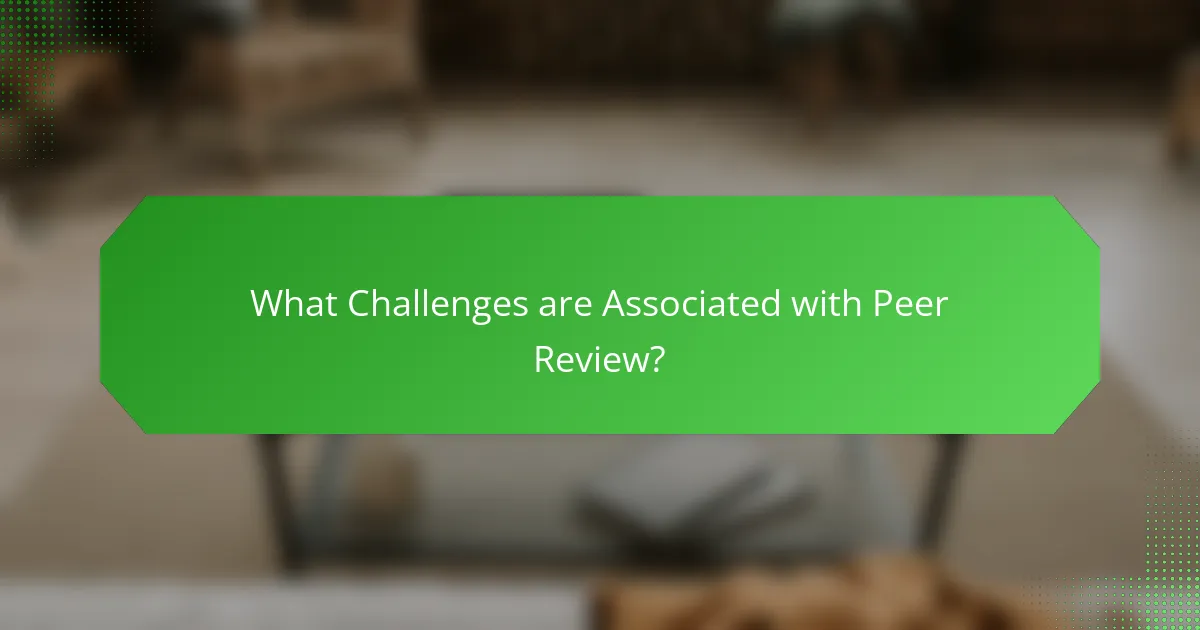
What Challenges are Associated with Peer Review?
Challenges associated with peer review include bias, inconsistency, and delays. Bias can arise from personal opinions of reviewers, affecting objectivity. Inconsistency occurs when different reviewers provide varying assessments of the same work. Delays in the review process can hinder timely publication. Additionally, the lack of transparency in reviewer identities can lead to accountability issues. According to a study published in “Nature” by Lee et al. (2013), 30% of authors reported experiencing significant delays in the peer review process. These challenges can undermine the effectiveness and credibility of scholarly publishing.
What common issues arise during the peer review process?
Common issues during the peer review process include delays, bias, and lack of transparency. Delays often occur due to the time taken for reviewers to assess submissions. Bias can arise from personal opinions or conflicts of interest affecting objectivity. Lack of transparency may result from anonymous reviews, making it difficult to address reviewer comments effectively. These issues can impact the quality and integrity of the publication process. Studies show that up to 30% of submissions experience significant delays in peer review. Addressing these challenges is crucial for maintaining the credibility of academic publishing.
How can biases affect the outcomes of peer review?
Biases can significantly affect the outcomes of peer review. They can lead to unfair evaluations of submitted work. For example, reviewer biases may stem from personal beliefs, institutional affiliations, or gender. These biases can result in favoritism towards certain authors or ideas. A study published in the journal “Nature” found that gender bias affects the likelihood of female scientists receiving favorable reviews. Additionally, biases can skew the assessment of the quality and originality of research. This can undermine the integrity of the peer review process. Ultimately, biases can hinder the advancement of knowledge and innovation in various fields.
What challenges do reviewers face in providing constructive feedback?
Reviewers face several challenges in providing constructive feedback. One major challenge is maintaining objectivity. Personal biases can influence their assessment of the work. Another challenge is the time commitment required for thorough evaluation. Reviewers often juggle multiple responsibilities, making it difficult to dedicate adequate time. Additionally, reviewers may struggle with articulating their critiques clearly. Complex ideas can be hard to convey effectively. There is also the challenge of balancing criticism with encouragement. Reviewers must ensure their feedback is constructive and supportive. Lastly, the lack of clarity in submission guidelines can create confusion. This can hinder the review process and impact the quality of feedback.
What are the implications of peer review challenges on publication ethics?
Peer review challenges significantly impact publication ethics by undermining the integrity of the scholarly communication process. These challenges can lead to biased evaluations, resulting in the rejection of valid research and the acceptance of flawed studies. Instances of reviewer conflicts of interest can compromise objectivity and fairness in the review process. Moreover, delays in peer review can hinder timely dissemination of research findings. According to a study published in the journal “Nature,” 30% of researchers reported experiencing bias in peer review. This bias can perpetuate systemic inequalities in academia. Furthermore, inadequate transparency in the peer review process can diminish trust in published research. Ethical breaches, such as plagiarism or data fabrication, may go unchecked due to ineffective peer review practices. Overall, these implications highlight the need for reforms to enhance the reliability and accountability of the peer review system.
How do issues in peer review affect the credibility of published research?
Issues in peer review significantly undermine the credibility of published research. Inadequate peer review can lead to the dissemination of flawed findings. Studies reveal that up to 30% of published research may contain errors due to insufficient scrutiny. Bias in reviewer selection can also skew results, impacting objectivity. Furthermore, lack of transparency in the peer review process raises doubts about the reliability of conclusions. A 2018 analysis indicated that peer-reviewed articles with methodological flaws are often cited without critical assessment. These factors collectively erode trust in scientific literature and can mislead further research and public policy.
What steps can be taken to mitigate challenges in the peer review process?
To mitigate challenges in the peer review process, journals can implement several strategies. First, establishing clear guidelines for reviewers can enhance consistency. These guidelines should outline expectations regarding feedback and timelines. Second, increasing reviewer training can improve the quality of reviews. Training can cover best practices and ethical considerations. Third, utilizing technology can streamline the review process. Automated systems can help track submissions and remind reviewers of deadlines. Fourth, maintaining a diverse pool of reviewers can reduce bias. A varied group brings different perspectives and expertise. Fifth, offering incentives for reviewers can encourage participation. Incentives may include recognition or access to resources. Lastly, fostering open communication between authors and reviewers can clarify expectations. Clear dialogue can lead to constructive feedback and better outcomes.
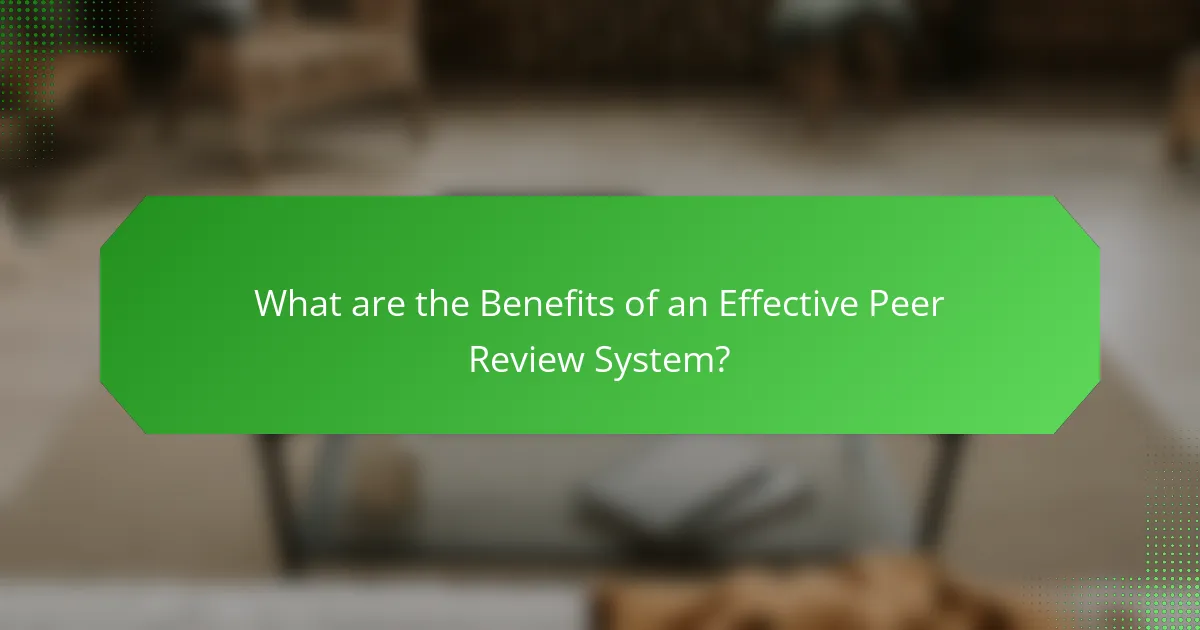
What are the Benefits of an Effective Peer Review System?
An effective peer review system enhances the quality of published research. It provides critical evaluation from experts in the field. This process helps identify errors and biases in research. Studies show that peer-reviewed articles are more reliable and credible. The peer review process also fosters academic integrity. It encourages transparency and accountability among researchers. Additionally, it can improve the overall quality of scholarship. Research indicates that peer-reviewed work is cited more frequently than non-reviewed work.
How does peer review enhance the quality of published research?
Peer review enhances the quality of published research by providing critical evaluation from experts in the field. This process ensures that research methodologies are sound and that results are valid. Reviewers assess the clarity and significance of the findings. They also identify potential biases and errors. The feedback helps authors improve their work before publication. Studies show that peer-reviewed articles are more likely to be cited than non-peer-reviewed ones. For instance, a study in the journal “PLOS ONE” found that peer-reviewed articles had a higher citation impact. Overall, peer review acts as a quality control mechanism in academic publishing.
What role does peer review play in advancing scientific knowledge?
Peer review plays a critical role in advancing scientific knowledge. It ensures the quality and credibility of research before publication. During peer review, experts evaluate the methodology, findings, and significance of the study. This process identifies errors and gaps in research, leading to necessary revisions.
The scrutiny helps maintain high standards in scientific literature. Research that passes peer review is more likely to be reliable and trustworthy. Studies indicate that peer-reviewed articles are cited more frequently than non-peer-reviewed ones. This citation trend underscores the impact of peer review on knowledge dissemination. Overall, peer review is essential for fostering scientific integrity and progress.
How does peer review contribute to the professional development of researchers?
Peer review contributes to the professional development of researchers by enhancing their critical thinking and analytical skills. It provides constructive feedback on research quality and methodology. This process helps researchers identify gaps in their work and improve their writing. Engaging in peer review fosters a deeper understanding of the field. It encourages collaboration and networking among researchers. Additionally, it increases visibility and credibility within the academic community. Researchers who participate in peer review gain insights into current trends and standards in their discipline. This ongoing engagement ultimately leads to higher quality research outputs.
What best practices can improve the peer review process?
Best practices to improve the peer review process include establishing clear guidelines for reviewers. Clear guidelines ensure that reviewers understand expectations and criteria for evaluation. Another practice is enhancing reviewer training programs. Training equips reviewers with skills to provide constructive feedback. Implementing a double-blind review process can also mitigate bias. This approach helps maintain objectivity by concealing authors’ identities from reviewers. Encouraging timely reviews is crucial for maintaining publication schedules. Timeliness reduces delays in the publication process. Additionally, utilizing technology for manuscript tracking can streamline submissions and communications. Tools like online submission systems facilitate efficient management of the review process. Regularly soliciting feedback from reviewers helps identify areas for improvement. Collecting and acting on this feedback fosters a culture of continuous enhancement in the peer review system.
How can journals implement effective peer review policies?
Journals can implement effective peer review policies by establishing clear guidelines for reviewers. These guidelines should outline the expectations for objectivity, confidentiality, and timely feedback. Journals should also create a robust system for selecting qualified reviewers based on their expertise. Training programs can enhance reviewers’ skills and understanding of the peer review process. Additionally, journals should encourage transparency by providing a platform for reviewers to disclose conflicts of interest. Regularly evaluating the peer review process can help identify areas for improvement. Implementing these strategies can enhance the credibility and quality of the publication process.
What strategies can researchers adopt to engage positively in peer review?
Researchers can adopt several strategies to engage positively in peer review. First, they should carefully read and follow the journal’s submission guidelines. This ensures that their manuscript meets the required standards. Second, researchers can provide clear and concise responses to reviewer comments. Addressing feedback thoroughly demonstrates respect for the review process. Third, maintaining professionalism in all communications is crucial. This fosters a constructive dialogue between authors and reviewers. Fourth, researchers should express gratitude for the reviewers’ time and effort. Acknowledging their contributions can create goodwill. Lastly, researchers can seek feedback from colleagues before submission. This can enhance the manuscript’s quality and potentially lead to a smoother review process.
The main entity of this article is peer review, a critical process in publication ethics that ensures the integrity and quality of scholarly work. The article outlines the role of peer review in maintaining ethical standards by evaluating the originality, validity, and significance of research submissions. It addresses the processes involved in peer review, the challenges such as bias and delays, and the benefits it offers to authors and the scientific community. Additionally, the article discusses different types of peer review and best practices for enhancing the effectiveness of the review process, ultimately highlighting its importance in advancing scientific knowledge and credibility.
